|
BACKGROUND
THE FEASTS
EASTON
FEAST; FESTIVALS - RELIGIOUS; ATONEMENT; ATONEMENT, DAY OF; AZAZEL; PASSOVER; PENTECOST; TABERNACLES, FEAST OF:
NEW BIBLE DICTIONARY
PASSOVER; PENTECOST, FEAST OF; TABERNACLES, FEAST OF:
The
full background to this teaching is available online at this link
THE FEASTS - BIBLE DICTIONARIES
|
Online links to scriptures (New International Version [NIV] unless otherwise stated) are shown in blue
| SPRING FEASTS
THE PATTERN OF THINGS PAST
FEAST OF UNLEAVENED BREAD
|
|
|
| INTRODUCTION |
|
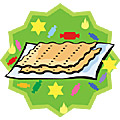 The Feast of Unleavened Bread is an extension or continuation of Passover, being celebrated over the week following the Feast of Passover. Hence the two Feasts can be considered to be one. The names of Passover and Unleavened Bread are interchangeable. The Feast of Firstfruits is also celebrated in the same week. These three feasts then, are looked upon as being integral parts of the same unit. The Feast of Unleavened Bread is an extension or continuation of Passover, being celebrated over the week following the Feast of Passover. Hence the two Feasts can be considered to be one. The names of Passover and Unleavened Bread are interchangeable. The Feast of Firstfruits is also celebrated in the same week. These three feasts then, are looked upon as being integral parts of the same unit.
|
|
|
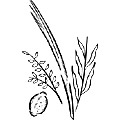 The Feast of Firstfruits, as we shall see shortly, is a bit of an oddity, not seeming to easily fit into the pattern of the other feasts, or indeed, into the pattern of the Tabernacle of Moses. For it is the only one of the feasts that does not include a Sabbath or Sacred Assembly. But that’s getting ahead of ourselves. So let’s first have a look at the ‘non-rising’, unleavened bread. The Feast of Firstfruits, as we shall see shortly, is a bit of an oddity, not seeming to easily fit into the pattern of the other feasts, or indeed, into the pattern of the Tabernacle of Moses. For it is the only one of the feasts that does not include a Sabbath or Sacred Assembly. But that’s getting ahead of ourselves. So let’s first have a look at the ‘non-rising’, unleavened bread.
|
| FEAST OF UNLEAVENED BREAD |
|
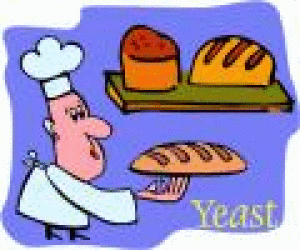 This feast starts on the 15th day of the first month (Religious Calendar), the day after the Passover, a Feast day, and finishes on the 21st day, with another Feast day. (15th to 21st inclusive, totals 7 days) Now, the people of the Old Testament are most unlikely to have understood the full significance of this day, for that was not revealed until New Testament times. To them it was representative haste, of having to prepare the Passover Meal in a hurry, of not having had time to wait for the rising effect of adding yeast (sourdough) to the bread to take effect, so leaving it out altogether. This feast starts on the 15th day of the first month (Religious Calendar), the day after the Passover, a Feast day, and finishes on the 21st day, with another Feast day. (15th to 21st inclusive, totals 7 days) Now, the people of the Old Testament are most unlikely to have understood the full significance of this day, for that was not revealed until New Testament times. To them it was representative haste, of having to prepare the Passover Meal in a hurry, of not having had time to wait for the rising effect of adding yeast (sourdough) to the bread to take effect, so leaving it out altogether.
Matthew 16:6
|
|
|
 Had I been living then, I think I would have had many questions to ask the priests about this bread. And I would have been unlikely to get satisfactory answers, for they were not revealed until New Testament times. For example. Why eat this bread for seven whole days? In the natural, you would think it would be a quick, one meal or day remembrance, similar to that of Passover night. Why was this unleavened bread used in all the feasts except Pentecost? And again, why did the priests have to eat such a lot of it? But I realise, I do ask too many questions! I also remember my Grandmother baking bread without yeast, for communion at our church when I was a boy. I have to admit that I am pleased that I wasn’t a priest back then, as both its taste and texture didn’t much appeal to me! Had I been living then, I think I would have had many questions to ask the priests about this bread. And I would have been unlikely to get satisfactory answers, for they were not revealed until New Testament times. For example. Why eat this bread for seven whole days? In the natural, you would think it would be a quick, one meal or day remembrance, similar to that of Passover night. Why was this unleavened bread used in all the feasts except Pentecost? And again, why did the priests have to eat such a lot of it? But I realise, I do ask too many questions! I also remember my Grandmother baking bread without yeast, for communion at our church when I was a boy. I have to admit that I am pleased that I wasn’t a priest back then, as both its taste and texture didn’t much appeal to me!
|
|
|
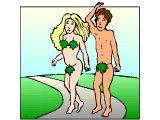 But when Jesus came, He revealed the true meaning of this tradition. Except for the one occasion, Jesus related yeast to sin. And what an apt metaphor it is too. For sin puffs up, as does yeast, and sin permeates and grows within our bodies from very small beginnings, if we let it. Just as a little yeast works its way through the bread to make it rise. Jesus used this simile to warn His listeners to beware of the leaven of both the Pharisees and the Sadducees. The Pharisees for their extreme ‘religious’ behaviour, asking people to do as they said, not as they did. And the Sadducees, for their ‘modern, liberal’ approach to the Scriptures, denying the reality of the supernatural, including later, the bodily resurrection of Jesus. Nothing is new! But when Jesus came, He revealed the true meaning of this tradition. Except for the one occasion, Jesus related yeast to sin. And what an apt metaphor it is too. For sin puffs up, as does yeast, and sin permeates and grows within our bodies from very small beginnings, if we let it. Just as a little yeast works its way through the bread to make it rise. Jesus used this simile to warn His listeners to beware of the leaven of both the Pharisees and the Sadducees. The Pharisees for their extreme ‘religious’ behaviour, asking people to do as they said, not as they did. And the Sadducees, for their ‘modern, liberal’ approach to the Scriptures, denying the reality of the supernatural, including later, the bodily resurrection of Jesus. Nothing is new!
|
|
|
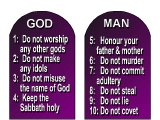 So the real significance of Unleavened Bread relates to purity. Paul explained this to the Corinthians when seeking to convince them to expel the man who was ‘living’ with his stepmother, surprisingly without the church taking action, a lack of action which indirectly reflects approval in the eyes of the world. So the real significance of Unleavened Bread relates to purity. Paul explained this to the Corinthians when seeking to convince them to expel the man who was ‘living’ with his stepmother, surprisingly without the church taking action, a lack of action which indirectly reflects approval in the eyes of the world.
1 Corinthians 5:6-8
|
|
|
 We can now understand why it formed such a symbolically significant part of the diet of the priests. For they were to be set apart from sin, to be different, to be bread without yeast. To live pure and holy lives. We can now understand why it formed such a symbolically significant part of the diet of the priests. For they were to be set apart from sin, to be different, to be bread without yeast. To live pure and holy lives.
The real significance of the unleavened bread then, was to symbolically separate the Jewish nation from the world, through pure and righteous living.
Yeast free bread for seven days. Seven here, as in several hundred other places in the Bible, represents completion. Complete separation through complete holiness, to be achieved through keeping the law.
|
|
|
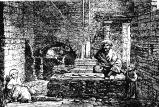 Now we know that we, just as the Jews in Old Testament times, are unable to keep the law. So we need help. And that help comes from Jesus. For Jesus declared, Now we know that we, just as the Jews in Old Testament times, are unable to keep the law. So we need help. And that help comes from Jesus. For Jesus declared,
A Baker's oven.
John 6:51
|
|
|
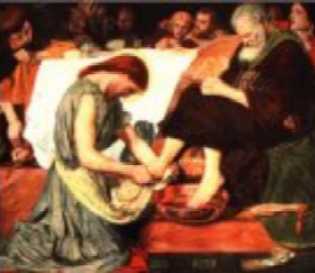 Yes, Jesus is the fulfilment of the Feast of Unleavened Bread. Our completion is complete! Through belief in Him, we are separated from the world and have been granted eternal life. Yes, Jesus is the fulfilment of the Feast of Unleavened Bread. Our completion is complete! Through belief in Him, we are separated from the world and have been granted eternal life.
|
|
|
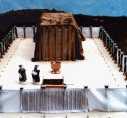 We can now also relate these first two feasts to the furniture in the Outer Court of the Tabernacle. The Feast of Passover obviously relates to the Brazen Altar on which the blood sacrifices were made. Jesus was the Passover lamb, as we have already discussed. The Feast of Unleavened Bread, on the other hand, represents the Washing Basin, the bread of holiness relating to the water of purification. We can now also relate these first two feasts to the furniture in the Outer Court of the Tabernacle. The Feast of Passover obviously relates to the Brazen Altar on which the blood sacrifices were made. Jesus was the Passover lamb, as we have already discussed. The Feast of Unleavened Bread, on the other hand, represents the Washing Basin, the bread of holiness relating to the water of purification.
|
|
|
 So we can link the blood and the water that poured from the side of the crucified Jesus to the fulfilment of the Feasts of Passover and Unleavened Bread. The blood and the water of the cross perfectly match up with the blood and the unleavened bread of the Feasts of Passover and Unleavened Bread. Jesus was, and is, the final completion of these feasts, both in the natural and in the spiritual. Amazing isn’t it, how the giant jigsaw of God’s plan fits together so easily when we search out His truth, linking together the individual pieces found within His treasure trove, the Bible. So we can link the blood and the water that poured from the side of the crucified Jesus to the fulfilment of the Feasts of Passover and Unleavened Bread. The blood and the water of the cross perfectly match up with the blood and the unleavened bread of the Feasts of Passover and Unleavened Bread. Jesus was, and is, the final completion of these feasts, both in the natural and in the spiritual. Amazing isn’t it, how the giant jigsaw of God’s plan fits together so easily when we search out His truth, linking together the individual pieces found within His treasure trove, the Bible.
|
| FEAST OF FIRST FRUITS |
|
 As mentioned at the beginning, this feast is the odd man out, being the only one that does not contain a Sabbath Day. This fact too, seems to preclude it from fitting into the pattern set by the furniture of the Tabernacle of Moses. For the other six feasts clearly relate to the six items of furniture the Tabernacle contained. So, what place did this feast have, and what role does it fulfil in God’s overall plan? As mentioned at the beginning, this feast is the odd man out, being the only one that does not contain a Sabbath Day. This fact too, seems to preclude it from fitting into the pattern set by the furniture of the Tabernacle of Moses. For the other six feasts clearly relate to the six items of furniture the Tabernacle contained. So, what place did this feast have, and what role does it fulfil in God’s overall plan?
1 Corinthians 15:20-23
So Christ, the perfect one, was raised (harvested) first, and we who believe in Him will follow in due time. The following bunches (us), although similar to the first one (perfect in Him), are still not of quite as high quality as the first. (Jesus)
That then is the real meaning of the Feast of Firstfruits. Jesus has completed His work by overcoming death and rising from the dead, the firstfruit of the general resurrection to come at the end of the age. The feast of the promise to come! And, as we are now coming to expect with the spiritual following the natural, it was celebrated on the day of His resurrection too.
|
|
|
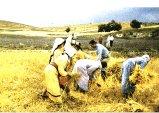 Its purpose was to give the people a foretaste of what was to come later in the year. In the natural, the less nutritious and tasty oat and barley harvests would be followed seven weeks later by the superior wheat harvest. In its turn, the wheat harvest would be followed 3-4 months later by the truly tasty and delicious fruit crops of figs, olives and grapes. Spiritually, the feast days too, follow this natural pattern. Pentecost was celebrated concurrent with the wheat harvest and the extra special Tabernacle feasts, during the fruit harvest season. Its purpose was to give the people a foretaste of what was to come later in the year. In the natural, the less nutritious and tasty oat and barley harvests would be followed seven weeks later by the superior wheat harvest. In its turn, the wheat harvest would be followed 3-4 months later by the truly tasty and delicious fruit crops of figs, olives and grapes. Spiritually, the feast days too, follow this natural pattern. Pentecost was celebrated concurrent with the wheat harvest and the extra special Tabernacle feasts, during the fruit harvest season.
Photo of the Corn Harvest
Not only was the offering selected from the first harvest, but it was to be the first of the first harvest. The full significance of this ‘first of the first’ is most easily understood to a crop farmer. For they know through experience, that the very best of a crop’s fruits or flowers mature right at the beginning of the harvest.
I understand this from personal experience. For a number of years Kathy and I were commercial flower growers, our primary crop being freesia flowers, grown for the New Zealand fresh flower market. Interestingly, we grew the flowers mainly from seed, rather than the traditional corms, (bulbs) for that way we could get earlier flowers and better prices. Being grown from seed, there was a much wider range of flowering times than for corm grown product.
|
|
|
 Now this was all in the days before I had heard of the Feast of Firstfruits. But it was always obvious to me, from personal observation that the strongest freesias flowered first. The strongest growing colour was the yellows and these were always the first to flower. Within the yellows too, the longest, strongest blooms would flower first. We would regularly get flowers up towards a metre tall, but the best of the early yellow blooms would grow 30% longer than this. Considerably taller than in the home garden! We would normally pick 2-4 stems off a plant by leaving part of the main stem on the plant during the first pick, then picking the side shoots later. The first bunch of yellows picked would always be the best bunch of the season, irrespective of how many tens of thousands of other bunches followed. Now this was all in the days before I had heard of the Feast of Firstfruits. But it was always obvious to me, from personal observation that the strongest freesias flowered first. The strongest growing colour was the yellows and these were always the first to flower. Within the yellows too, the longest, strongest blooms would flower first. We would regularly get flowers up towards a metre tall, but the best of the early yellow blooms would grow 30% longer than this. Considerably taller than in the home garden! We would normally pick 2-4 stems off a plant by leaving part of the main stem on the plant during the first pick, then picking the side shoots later. The first bunch of yellows picked would always be the best bunch of the season, irrespective of how many tens of thousands of other bunches followed.
|
|
|
 So this first of the first, this special sheaf of barley, would have represented the very best of the crop. And who spiritually is the best of the crop? Why, Jesus of course! Paul obviously understood this and applied it to the resurrection of Jesus. By now, you will not be surprised to learn that this feast took place at the same time as His resurrection. For God had perfectly planned everything, before time began. So this first of the first, this special sheaf of barley, would have represented the very best of the crop. And who spiritually is the best of the crop? Why, Jesus of course! Paul obviously understood this and applied it to the resurrection of Jesus. By now, you will not be surprised to learn that this feast took place at the same time as His resurrection. For God had perfectly planned everything, before time began.
Let’s see then, what Paul had to say about it.
1 Corinthians 15:20-23
|
|
|
So Christ, the perfect one, was raised (harvested) first, and we who believe in Him will follow in due time. The following bunches (us), although similar to the first one (perfect in Him), are still not of quite as high quality as the first. (Jesus)
That then is the real meaning of the Feast of Firstfruits. Jesus has completed His work by overcoming death and rising from the dead, the firstfruit of the general resurrection to come at the end of the age. The feast of the promise to come! And, as we are now coming to expect with the spiritual following the natural, it was celebrated on the day of His resurrection too.
Is it too much to expect for the same to apply to Pentecost and Tabernacles? Let’s see next week.
|
| <i>NEXT WEEK</i>
THE PROPHETIC FEASTS OF THE LORD - Series 1 -
THE SPRING FEASTS - Part 6
|
|
 Come and celebrate the wheat harvest with the Jewish people in the Feast of Pentecost. And celebrate even more the coming of the Holy Spirit in the first Pentecost after the death of Jesus! Come and celebrate the wheat harvest with the Jewish people in the Feast of Pentecost. And celebrate even more the coming of the Holy Spirit in the first Pentecost after the death of Jesus!
|
| A NOTE FROM DAVID |
|
 Of course, Jesus is so much more than the Passover Lamb. the whole world cannot contain Him! so today we have seen the aspects of holiness and of Him being the first of many believers. Of course, Jesus is so much more than the Passover Lamb. the whole world cannot contain Him! so today we have seen the aspects of holiness and of Him being the first of many believers.
It is now up to us to live holy lives and to take his Word out to the world. For if the people are not told, how will they hear of the Good News?
New Zealanders are generally recognised as being good allrounders, so the relatively new sport of Triathlon, involving, swimming, cycling and running appeals to us. It is excellent for all round fitness and health, but it takes a lot of time for training, as 3 different sports are involved. For a small country we have produced an amazing number of world champions. However, probably the highlight has been at the recent Olympic Games in Greece where, in the men's event, New Zealanders won both the Gold (Hamish Carter) and Silver (Bevan Docherty - also World Champion) medals. They are pictured here enjoying the moment!
|
So until next week.......
MAY GOD BLESS YOU AND YOU BLESS GOD!
His servant and yours
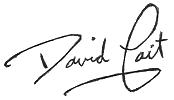
Learn more about us at...
www.wwj.org.nz/about.php
|
A DAVID'S DOODLING
721. There is still no greater power working in the world today than that of the Cross of Jesus.
David Tait
|
Check
out the WWJ website for….
More David's Doodlings: www.wwj.org.nz/dd.php
A look at some of lifes curious questions: http://www.wwj.org.nz/why.php
Everything you ever wanted to know about....: http://www.wwj.org.nz/exex.php
Life's a Laugh: http://www.wwj.org.nz/lifelaugh.php
Links to other sites of interest: http://www.wwj.org.nz/links.php
|

 The Feast of Unleavened Bread is an extension or continuation of Passover, being celebrated over the week following the Feast of Passover. Hence the two Feasts can be considered to be one. The names of Passover and Unleavened Bread are interchangeable. The Feast of Firstfruits is also celebrated in the same week. These three feasts then, are looked upon as being integral parts of the same unit.
The Feast of Unleavened Bread is an extension or continuation of Passover, being celebrated over the week following the Feast of Passover. Hence the two Feasts can be considered to be one. The names of Passover and Unleavened Bread are interchangeable. The Feast of Firstfruits is also celebrated in the same week. These three feasts then, are looked upon as being integral parts of the same unit.  The Feast of Firstfruits, as we shall see shortly, is a bit of an oddity, not seeming to easily fit into the pattern of the other feasts, or indeed, into the pattern of the Tabernacle of Moses. For it is the only one of the feasts that does not include a Sabbath or Sacred Assembly. But that’s getting ahead of ourselves. So let’s first have a look at the ‘non-rising’, unleavened bread.
The Feast of Firstfruits, as we shall see shortly, is a bit of an oddity, not seeming to easily fit into the pattern of the other feasts, or indeed, into the pattern of the Tabernacle of Moses. For it is the only one of the feasts that does not include a Sabbath or Sacred Assembly. But that’s getting ahead of ourselves. So let’s first have a look at the ‘non-rising’, unleavened bread.  This feast starts on the 15th day of the first month (Religious Calendar), the day after the Passover, a Feast day, and finishes on the 21st day, with another Feast day. (15th to 21st inclusive, totals 7 days) Now, the people of the Old Testament are most unlikely to have understood the full significance of this day, for that was not revealed until New Testament times. To them it was representative haste, of having to prepare the Passover Meal in a hurry, of not having had time to wait for the rising effect of adding yeast (sourdough) to the bread to take effect, so leaving it out altogether.
This feast starts on the 15th day of the first month (Religious Calendar), the day after the Passover, a Feast day, and finishes on the 21st day, with another Feast day. (15th to 21st inclusive, totals 7 days) Now, the people of the Old Testament are most unlikely to have understood the full significance of this day, for that was not revealed until New Testament times. To them it was representative haste, of having to prepare the Passover Meal in a hurry, of not having had time to wait for the rising effect of adding yeast (sourdough) to the bread to take effect, so leaving it out altogether.  Had I been living then, I think I would have had many questions to ask the priests about this bread. And I would have been unlikely to get satisfactory answers, for they were not revealed until New Testament times. For example. Why eat this bread for seven whole days? In the natural, you would think it would be a quick, one meal or day remembrance, similar to that of Passover night. Why was this unleavened bread used in all the feasts except Pentecost? And again, why did the priests have to eat such a lot of it? But I realise, I do ask too many questions! I also remember my Grandmother baking bread without yeast, for communion at our church when I was a boy. I have to admit that I am pleased that I wasn’t a priest back then, as both its taste and texture didn’t much appeal to me!
Had I been living then, I think I would have had many questions to ask the priests about this bread. And I would have been unlikely to get satisfactory answers, for they were not revealed until New Testament times. For example. Why eat this bread for seven whole days? In the natural, you would think it would be a quick, one meal or day remembrance, similar to that of Passover night. Why was this unleavened bread used in all the feasts except Pentecost? And again, why did the priests have to eat such a lot of it? But I realise, I do ask too many questions! I also remember my Grandmother baking bread without yeast, for communion at our church when I was a boy. I have to admit that I am pleased that I wasn’t a priest back then, as both its taste and texture didn’t much appeal to me!  But when Jesus came, He revealed the true meaning of this tradition. Except for the one occasion, Jesus related yeast to sin. And what an apt metaphor it is too. For sin puffs up, as does yeast, and sin permeates and grows within our bodies from very small beginnings, if we let it. Just as a little yeast works its way through the bread to make it rise. Jesus used this simile to warn His listeners to beware of the leaven of both the Pharisees and the Sadducees. The Pharisees for their extreme ‘religious’ behaviour, asking people to do as they said, not as they did. And the Sadducees, for their ‘modern, liberal’ approach to the Scriptures, denying the reality of the supernatural, including later, the bodily resurrection of Jesus. Nothing is new!
But when Jesus came, He revealed the true meaning of this tradition. Except for the one occasion, Jesus related yeast to sin. And what an apt metaphor it is too. For sin puffs up, as does yeast, and sin permeates and grows within our bodies from very small beginnings, if we let it. Just as a little yeast works its way through the bread to make it rise. Jesus used this simile to warn His listeners to beware of the leaven of both the Pharisees and the Sadducees. The Pharisees for their extreme ‘religious’ behaviour, asking people to do as they said, not as they did. And the Sadducees, for their ‘modern, liberal’ approach to the Scriptures, denying the reality of the supernatural, including later, the bodily resurrection of Jesus. Nothing is new!  So the real significance of Unleavened Bread relates to purity. Paul explained this to the Corinthians when seeking to convince them to expel the man who was ‘living’ with his stepmother, surprisingly without the church taking action, a lack of action which indirectly reflects approval in the eyes of the world.
So the real significance of Unleavened Bread relates to purity. Paul explained this to the Corinthians when seeking to convince them to expel the man who was ‘living’ with his stepmother, surprisingly without the church taking action, a lack of action which indirectly reflects approval in the eyes of the world.  We can now understand why it formed such a symbolically significant part of the diet of the priests. For they were to be set apart from sin, to be different, to be bread without yeast. To live pure and holy lives.
We can now understand why it formed such a symbolically significant part of the diet of the priests. For they were to be set apart from sin, to be different, to be bread without yeast. To live pure and holy lives.  Now we know that we, just as the Jews in Old Testament times, are unable to keep the law. So we need help. And that help comes from Jesus. For Jesus declared,
Now we know that we, just as the Jews in Old Testament times, are unable to keep the law. So we need help. And that help comes from Jesus. For Jesus declared, Yes, Jesus is the fulfilment of the Feast of Unleavened Bread. Our completion is complete! Through belief in Him, we are separated from the world and have been granted eternal life.
Yes, Jesus is the fulfilment of the Feast of Unleavened Bread. Our completion is complete! Through belief in Him, we are separated from the world and have been granted eternal life. We can now also relate these first two feasts to the furniture in the Outer Court of the Tabernacle. The Feast of Passover obviously relates to the Brazen Altar on which the blood sacrifices were made. Jesus was the Passover lamb, as we have already discussed. The Feast of Unleavened Bread, on the other hand, represents the Washing Basin, the bread of holiness relating to the water of purification.
We can now also relate these first two feasts to the furniture in the Outer Court of the Tabernacle. The Feast of Passover obviously relates to the Brazen Altar on which the blood sacrifices were made. Jesus was the Passover lamb, as we have already discussed. The Feast of Unleavened Bread, on the other hand, represents the Washing Basin, the bread of holiness relating to the water of purification. So we can link the blood and the water that poured from the side of the crucified Jesus to the fulfilment of the Feasts of Passover and Unleavened Bread. The blood and the water of the cross perfectly match up with the blood and the unleavened bread of the Feasts of Passover and Unleavened Bread. Jesus was, and is, the final completion of these feasts, both in the natural and in the spiritual. Amazing isn’t it, how the giant jigsaw of God’s plan fits together so easily when we search out His truth, linking together the individual pieces found within His treasure trove, the Bible.
So we can link the blood and the water that poured from the side of the crucified Jesus to the fulfilment of the Feasts of Passover and Unleavened Bread. The blood and the water of the cross perfectly match up with the blood and the unleavened bread of the Feasts of Passover and Unleavened Bread. Jesus was, and is, the final completion of these feasts, both in the natural and in the spiritual. Amazing isn’t it, how the giant jigsaw of God’s plan fits together so easily when we search out His truth, linking together the individual pieces found within His treasure trove, the Bible.  As mentioned at the beginning, this feast is the odd man out, being the only one that does not contain a Sabbath Day. This fact too, seems to preclude it from fitting into the pattern set by the furniture of the Tabernacle of Moses. For the other six feasts clearly relate to the six items of furniture the Tabernacle contained. So, what place did this feast have, and what role does it fulfil in God’s overall plan?
As mentioned at the beginning, this feast is the odd man out, being the only one that does not contain a Sabbath Day. This fact too, seems to preclude it from fitting into the pattern set by the furniture of the Tabernacle of Moses. For the other six feasts clearly relate to the six items of furniture the Tabernacle contained. So, what place did this feast have, and what role does it fulfil in God’s overall plan?  Its purpose was to give the people a foretaste of what was to come later in the year. In the natural, the less nutritious and tasty oat and barley harvests would be followed seven weeks later by the superior wheat harvest. In its turn, the wheat harvest would be followed 3-4 months later by the truly tasty and delicious fruit crops of figs, olives and grapes. Spiritually, the feast days too, follow this natural pattern. Pentecost was celebrated concurrent with the wheat harvest and the extra special Tabernacle feasts, during the fruit harvest season.
Its purpose was to give the people a foretaste of what was to come later in the year. In the natural, the less nutritious and tasty oat and barley harvests would be followed seven weeks later by the superior wheat harvest. In its turn, the wheat harvest would be followed 3-4 months later by the truly tasty and delicious fruit crops of figs, olives and grapes. Spiritually, the feast days too, follow this natural pattern. Pentecost was celebrated concurrent with the wheat harvest and the extra special Tabernacle feasts, during the fruit harvest season. Now this was all in the days before I had heard of the Feast of Firstfruits. But it was always obvious to me, from personal observation that the strongest freesias flowered first. The strongest growing colour was the yellows and these were always the first to flower. Within the yellows too, the longest, strongest blooms would flower first. We would regularly get flowers up towards a metre tall, but the best of the early yellow blooms would grow 30% longer than this. Considerably taller than in the home garden! We would normally pick 2-4 stems off a plant by leaving part of the main stem on the plant during the first pick, then picking the side shoots later. The first bunch of yellows picked would always be the best bunch of the season, irrespective of how many tens of thousands of other bunches followed.
Now this was all in the days before I had heard of the Feast of Firstfruits. But it was always obvious to me, from personal observation that the strongest freesias flowered first. The strongest growing colour was the yellows and these were always the first to flower. Within the yellows too, the longest, strongest blooms would flower first. We would regularly get flowers up towards a metre tall, but the best of the early yellow blooms would grow 30% longer than this. Considerably taller than in the home garden! We would normally pick 2-4 stems off a plant by leaving part of the main stem on the plant during the first pick, then picking the side shoots later. The first bunch of yellows picked would always be the best bunch of the season, irrespective of how many tens of thousands of other bunches followed.  So this first of the first, this special sheaf of barley, would have represented the very best of the crop. And who spiritually is the best of the crop? Why, Jesus of course! Paul obviously understood this and applied it to the resurrection of Jesus. By now, you will not be surprised to learn that this feast took place at the same time as His resurrection. For God had perfectly planned everything, before time began.
So this first of the first, this special sheaf of barley, would have represented the very best of the crop. And who spiritually is the best of the crop? Why, Jesus of course! Paul obviously understood this and applied it to the resurrection of Jesus. By now, you will not be surprised to learn that this feast took place at the same time as His resurrection. For God had perfectly planned everything, before time began.  Come and celebrate the wheat harvest with the Jewish people in the Feast of Pentecost. And celebrate even more the coming of the Holy Spirit in the first Pentecost after the death of Jesus!
Come and celebrate the wheat harvest with the Jewish people in the Feast of Pentecost. And celebrate even more the coming of the Holy Spirit in the first Pentecost after the death of Jesus!  Of course, Jesus is so much more than the Passover Lamb. the whole world cannot contain Him! so today we have seen the aspects of holiness and of Him being the first of many believers.
Of course, Jesus is so much more than the Passover Lamb. the whole world cannot contain Him! so today we have seen the aspects of holiness and of Him being the first of many believers. 